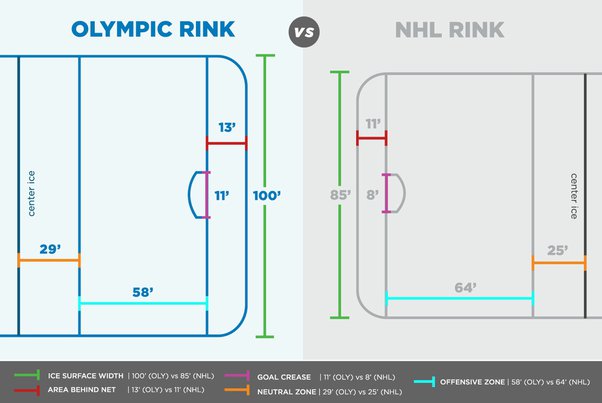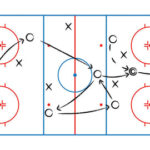Not all NHL hockey rinks are the same size. The standard dimensions are 200 feet by 85 feet.
NHL hockey rinks may vary slightly in size, though the standard dimension is 200 feet long and 85 feet wide. This standardization ensures a consistent playing experience across the league. Some older arenas may have minor deviations in rink size due to construction constraints.
These differences can influence gameplay, as players and teams adapt their strategies to the unique characteristics of each rink. Understanding rink dimensions is essential for fans and players alike, providing insights into game dynamics. The standard size promotes fairness and uniformity, crucial for maintaining the competitive balance in the NHL.

Credit: www.athletica.com
Standard Dimensions
Many people think all hockey rinks are the same size. This is not true. Rink sizes can vary. This affects the game and player strategies.
Nhl Official Rink Size
The NHL has a standard rink size. The rink is 200 feet long and 85 feet wide. The corners are rounded. The goal line is 11 feet from the end boards. The neutral zone is 50 feet long.
Here is a breakdown of the NHL rink dimensions:
| Feature | Dimension |
|---|---|
| Rink Length | 200 feet |
| Rink Width | 85 feet |
| Goal Line to End Boards | 11 feet |
| Neutral Zone Length | 50 feet |
Comparison To International Rinks
International rinks are usually bigger. They are 200 feet long but 100 feet wide. This extra width changes the game pace. Players have more space to move.
Here is a comparison between NHL and international rinks:
| Feature | NHL Rink | International Rink |
|---|---|---|
| Rink Length | 200 feet | 200 feet |
| Rink Width | 85 feet | 100 feet |
| Goal Line to End Boards | 11 feet | 13 feet |
| Neutral Zone Length | 50 feet | 58 feet |
These differences can be significant. They affect game strategies. Players need to adapt their styles. International rinks offer more open ice. This can lead to faster skating and more scoring chances.
Historical Changes
The size of NHL hockey rinks has changed over time. These changes reflect historical needs and preferences. The evolution of rink sizes has impacted the game significantly. Below, we explore these historical changes in detail.
Evolution Of Rink Sizes
In the early days, rinks were not standardized. Sizes varied greatly from one location to another. This inconsistency affected the style of play. Smaller rinks led to a faster, more physical game. Larger rinks allowed for more strategic play.
The NHL adopted a standard rink size in 1929. This size was 200 feet by 85 feet. This standardization helped unify the league. Every team played under the same conditions. The game became more predictable and fair.
International rinks, however, remained larger. They measured 200 feet by 100 feet. This size difference influenced international competitions. Players had to adjust their style of play.
Influence Of Arena Architecture
Arena architecture also influenced rink sizes. Older arenas often had space constraints. This led to smaller rinks in some locations. Newer arenas could accommodate larger, standardized rinks. This shift helped with the NHL’s standardization efforts.
Architects had to balance seating capacity and rink size. More seats meant more revenue. But, the rink size had to meet league standards. This balance was crucial for modern arena designs.
Technology also played a role. Advanced refrigeration systems allowed for larger rinks. Earlier systems could not maintain ice quality on larger surfaces. This technological progress supported the move to standardized rink sizes.
Overall, the historical changes in NHL rink sizes show a blend of tradition and innovation. These changes have shaped the game we love today.
Unique Rinks
Hockey rinks are not all the same size. Some rinks are unique due to their non-standard dimensions. These unique rinks add a different flavor to the game. Players and fans love these special venues.
Famous Non-standard Rinks
Some NHL rinks are well-known for their unique sizes. Here are a few:
- Boston Garden: This rink was smaller than most. It measured 191 feet by 83 feet.
- Buffalo Memorial Auditorium: This rink also had unique dimensions, measuring 196 feet by 85 feet.
- Chicago Stadium: Another famous rink with non-standard size. It was 185 feet by 85 feet.
Case Studies
Let’s look at how these unique rinks affected the game:
| Rink | Impact |
|---|---|
| Boston Garden | Players had less room to maneuver. This led to a more physical game. |
| Buffalo Memorial Auditorium | Goalies had to adjust their angles. This changed the way they played. |
| Chicago Stadium | Teams had to change their strategies. The smaller rink made a fast game. |
Each of these rinks provided a unique challenge. Players and teams had to adapt to the different sizes. This made the game more interesting for fans.

Credit: novacapsfans.com
Impact On Gameplay
Not all NHL hockey rinks are the same size. This difference impacts the game significantly. The rink’s size affects the players’ speed, strategies, and overall gameplay dynamics.
Speed And Space
Rink size directly influences player speed and available space. A smaller rink means less space. Players have less room to maneuver and pass. This leads to a faster, more intense game.
In a larger rink, players can spread out more. They have more time to think and plan their moves. This can lead to a more strategic style of play.
| Rink Size | Speed | Space |
|---|---|---|
| Smaller | Faster | Less |
| Larger | Slower | More |
Strategic Adjustments
Teams must adjust their strategies based on rink size. On a smaller rink, quick passes are crucial. Players need to be agile and ready to react quickly.
On a larger rink, long passes are more effective. Players can use the extra space to create more opportunities. Coaches must plan differently for each rink size.
- Quick passes for small rinks
- Long passes for large rinks
- Agility is key in small spaces
- Strategic positioning in larger areas
Player Preferences
Hockey players have their own preferences about rink size. These preferences can impact their performance and comfort on the ice. Some players favor larger rinks for more space, while others prefer smaller rinks for quicker play.
Interviews With Players
We spoke to several NHL players about their rink size preferences. Their insights provide a unique look into how rink dimensions affect their game.
- Player A: “I like larger rinks. They give me more space to maneuver.”
- Player B: “Smaller rinks are better. They make the game faster and more exciting.”
- Player C: “I adjust to any rink size. But, I prefer a medium size.”
Rink Size And Performance
Rink size directly impacts player performance. Below is a table showing the effects of different rink sizes:
| Rink Size | Player Movement | Game Speed |
|---|---|---|
| Large | More room for skills | Slower pace |
| Medium | Balanced | Moderate pace |
| Small | Less room | Faster pace |
Players must adapt their strategies to the rink size. Larger rinks require endurance. Smaller rinks need quick reflexes.
Future Trends
The future of NHL hockey rinks is an exciting topic. Changes and improvements are always on the horizon. Let’s dive into potential trends shaping the future of NHL rinks.
Potential Standardization
There is talk of making all NHL rinks the same size. Today, rinks can vary slightly in dimensions. Standardizing rink size could create a fairer playing field.
Benefits of standardization include:
- Improved player training
- Consistent game strategies
- Better fan experience
Standardization might also help international play. Many countries use different rink sizes. Aligning NHL rinks with international standards could simplify global tournaments.
Innovations In Rink Design
New technologies are changing rink design. These innovations aim to enhance safety, performance, and fan engagement. Here are some exciting trends:
- Smart Ice: Sensors in the ice can track puck and player movement. This data helps coaches and analysts.
- Energy Efficiency: Modern rinks use eco-friendly materials. They also employ energy-saving technologies. This reduces the environmental footprint.
- Advanced Glass: New glass designs improve player safety. They also offer better visibility for fans.
Other innovations include:
| Innovation | Benefit |
|---|---|
| Flexible Boards | Reduces player injuries |
| LED Lighting | Enhances visibility and energy efficiency |
| Enhanced Audio Systems | Improves fan experience |
These trends highlight the future of hockey rinks. The goal is to make the game safer, fairer, and more exciting for everyone.

Credit: www.therinklive.com
Conclusion
Understanding NHL rink sizes can enhance your appreciation of the game. Each rink has unique dimensions and characteristics. This diversity adds excitement and challenges for players. Whether you’re a fan or a player, knowing rink differences can deepen your hockey experience.
Explore more about NHL rinks to enrich your knowledge and enjoyment.


